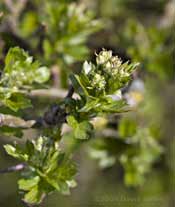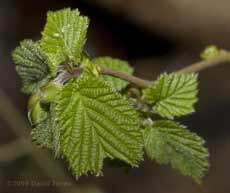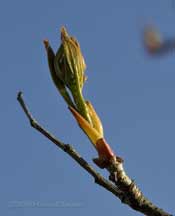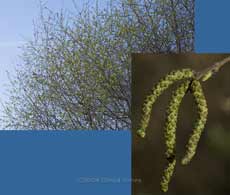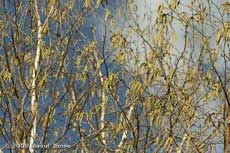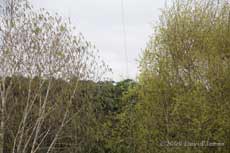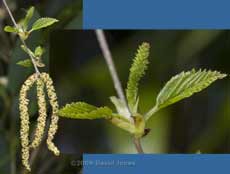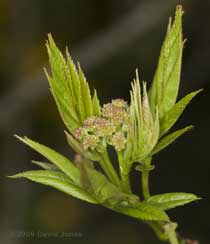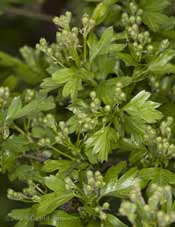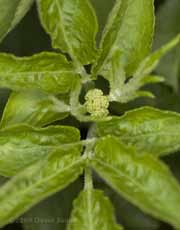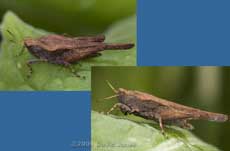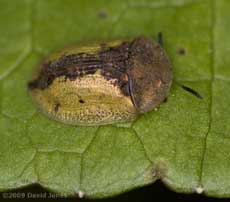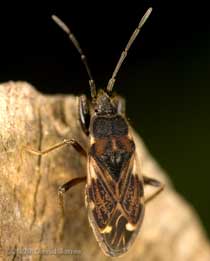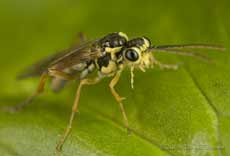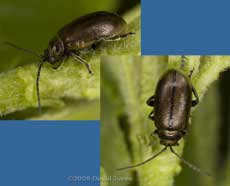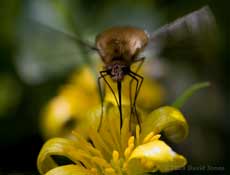Go to the last entry on this page .....Go to previous entry4 April - A bright and breezy day with the temperature reaching just short of 16C. Activity in the nest boxes continues to occupy much of my time, but today I have managed to spend a bit of time in the garden.
I missed the bursting of the Hawthorn leaf buds on the lower parts of the tree. While they have yet to emerge on the upper branches, the leaves on the lower branches are expanding and exposing the bunches of flower buds.
Next to the Ivy tree the leaves on the Hazel saplings are also turning green (their buds burst on 19 March).
You have to look up to see that the Rowan buds have now burst, the first opened yesterday.
Finally, every Spring there is a striking difference between our neighbours' Silver Birch and our Himalayan Birch. While the Silver Birch is now gaining its green foliage, the buds and the male catkins on our Birch are still firmly closed.
The feeders are rather quiet at the moment, although there are a small number of Siskins about, along with similar numbers of Goldfinches. The Long-tailed Tits make just one or two visits each day, as do a couple of Coal Tits. I'm hardly seeing the Starlings in the garden during the days. At the bee hotels the first of the solitary bees are active (probably) Tawny Mining Bee (Andrena fulva) although I haven't managed any pictures as yet, and this afternoon I saw a Common Carder Bumblebee queen visiting the flowers in the garden. I wonder if it is the same one that visited the Robin box two days ago. I wonder if we will have the species nesting in the moss by the pond this year.
14 April - At last, an garden update! First though, a couple of people to thank for IDs - in chronological order. On I took some photographs of an insect larva and ants on an Oak log. Tim Norriss (Recorder of Moths in Hampshire) identified the larva as that of a micro moth called Luffia ferchaultella which is a common and widespread species. This is an interesting species as it seems that in the adult stage only wingless females are known. The log is being kept in a container so I will be watching for any change in the larva. Bob Saville (National Barkfly Recording Scheme organiser) got in contact with an ant expert who came up with an ID for the ants on the log. The species is Temnothorax nylanderi, which has a limited distribution in Britain and is found mainly in the South East. Since my last report on the garden some much needed rain has helped the garden take advantage of Spring sunshine, and it is really turning green here now.
Over the last week our Himalayan Birch has transformed as the male catkins opened up to start scattering their yellow pollen.
By the weekend you could see how different it is to our neighbour's Silver Birch, on the right in this picture.
Today I've noticed that our Birch has reached the next stage in its progress through Spring as the female flowers are also opening. They are emerging, along with the first leaves, from buds set back from the male inflorescences. While the staged appearance of male and female flowers is intended to encourage cross pollination by the wind, there is obviously enough of an overlap to allow for self pollination as well.
In contrast to the Birch, the Rowan leaves have grown quite a bit in the last ten days, although, and its flower buds are still tightly closed for the moment.
At the other end of the garden the Hawthorn is absolutely covered with flower buds now. I just hope that the weather remains favourable to the insects that they will need for pollination. Last year was very disappointing with very few berries produced.
Next to the Hawthorn, the Elder is also covered with well developed foliage, but its flower buds still have a long way to go before they are ready to open.
As I mentioned in yesterday's nest box diary, I fell victim to a bug on the weekend and spent time flat on my back. However, with it a sunny day outside I couldn't resist at least one stroll down the garden - and it was worth it, as I came up with two new sightings for the garden.
Unlike in grasshoppers, their front wings are reduced to a small scaly disc. Despite this they can fly, and according to my insect guide they can also swim well!
The second newcomer was this (I think) Cassida sanguinolenta on a March Marigold leaf. One of the Tortoise beetles, it measured just under 8mm in length.
I'm not sure if this is also a first. This boldly marked bug was resting on top of a log that is in the middle of the Marsh Marigolds. I have yet to attempt an ID for it.
This morning on another Marsh Marigold leaf was this sawfly that appears to have spent the night there - the leaf was still in shade and had dew on it. This is another insect that I need to provide an ID for it.
On the Elder I found a couple of these beetles which are just over 5mm in length. It could be Lochmaea capreae or one
of several related species that can be found on Hawthorn and willows (there
is a small Willow next to the Elder). I need to take a closer look to see if
the beetle's elytra is covered with down.
There are lots of hoverflies about now, and the solitary bees are becoming very active, and today I saw mating activities amongst the Tawny Mining Bees.
It wasn't quite hovering as it fed, but the legs seemed to be just steadying rather than supporting it as it probed the flower.
On the bird front the garden has gone rather quiet now. The House Sparrows have once again become the main species, and they spend a lot of time going between the garden and their boxes. I have yet to see them hunting for insects so I guess there are no young to be fed yet. We still have Goldfinches and Siskins visiting but in much reduced numbers, and I haven't seen any Greenfinches, Long-tailed Tits or Siskins for a week, but we still get visits from one or two Coal Tits.
15 April - A day that started with a cracking thunderstorm before dawn that preceded a bright day outside. Indoors it wasn't so bright - my bug seems to have regained some of its vigour and is not only causing me grief, but it seems to have infected my PC! I shut that down last night after completing yesterday's entry, but this morning pressing the on button has had no effect. It doesn't power up at all. I've checked the mains fuse, and used a different mains lead with no luck. It looks as though the power supply has failed. I wondered briefly if the thunderstorm had anything to do with it, but all the other devices that are being used in the monitoring of the nest boxes are still working despite being switched on during the storm. I may be relying on my laptop for a few days.... Just one item from the garden today. While the solitary bees are enjoying all the flowers that are open at the moment, there are not many bumblebees around at the moment. However, amongst the bumblebees that are coming into the garden there are some that appear to be all black. I must try to get some pictures so that I can at least attempt to identify the species. Click on images to see larger versions |
|
